Art of the Genre: Rise of the Runelords
There’s something nice about being in L.A. Sure, it has a bad rap, but when the snow is thick in Chicago, and the wind is blowing off the lake, it didn’t take much for Ryan Harvey and I to jump at John O’Neill’s offer to spearhead a Los Angeles satellite office of BG. Ryan picked a great spot, a six story complex right off the Redondo Pier, the view of the Pacific and the strand of beach below a perfect change from the snow and riveted metal of the BG Tower, my old office view completely obstructed by the zeppelin docking gangway.
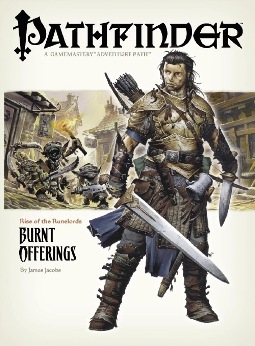 Anyway, I digress, what I was saying is that it’s nice to be in sunny southern California, and when O’Neill sent a telegraph that I had to fly to Seattle for an interview I wasn’t all smiles, that is until I discovered the person and the subject matter of the interview. [Note: He probably did this to drum up business for Howard Andrew Jones’s first Pathfinder novel Plague of Shadows, but I’ll take it… oh, and READ the book, it is awesome!]
Anyway, I digress, what I was saying is that it’s nice to be in sunny southern California, and when O’Neill sent a telegraph that I had to fly to Seattle for an interview I wasn’t all smiles, that is until I discovered the person and the subject matter of the interview. [Note: He probably did this to drum up business for Howard Andrew Jones’s first Pathfinder novel Plague of Shadows, but I’ll take it… oh, and READ the book, it is awesome!]
The place, the new Paizo HQ in Redmond Washington, just outside of Seattle. On an aside here, after playing Shadowrun till my eyes bled in college, I pretty much knew Seattle like I was born and raised there so Redmond for me was old hat. The person, Editor-in-Chief James Jacobs, and the subject Paizo’s first Pathfinder series, the 2007 classic, Rise of the Runelords.
After devoting the appropriate time to rubbing the assignment in Ryan’s face, I jumped a flight to Seattle and the rain and gloom of the northwest. While airborne, I contacted Wayne Reynolds who was featured in Burnt Offerings and the rest of the Rise of the Runelords series. I figured if I was going to do this, I better include some never before seen art, and as Wayne did the Iconics, why not see what he could come up with from his files. Note: Wayne did a Pathfinder Iconic for Black Gate that can be found here.
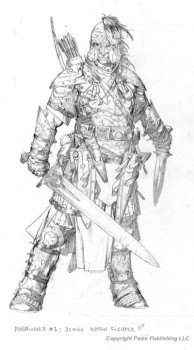
When I landed, Paizo had a car and driver waiting for me, and as I rolled up outside the Paizo complex I was greeted by non-other than CEO Lisa Stevens. This blond-haired bombshell is tall to begin with, but add a black pinstripe business suit and four inch heels and she’s downright daunting. Her smile and elder dungeon master’s demeanor put me right at ease, however, and after loading me up with enough free Paizo swag to make Ryan weep, I was given a grand tour that concluded with my first meeting with James Jacobs.
James looked far younger than I’d imagined, perhaps the regenerative power of role-playing keeping him young, and he greeted me with a smile and sturdy handshake. To me, he looked the part of Penn to Paizo Publisher Erik Mona’s Teller, and the sheer intimidation factor that he’d gotten his first role-playing adventure published in Dungeon magazine at age fourteen kept me on my toes. James later commented that I looked like Sean K Reynolds, but I told him both Sean and I stole our look from Shel Silverstine, so it’s easy to get confused.
Still, James was kind, and offered to take me out to the Pomegranate Bistro on the company dime. It was wonderful setting, and I had the arugula, prosciutto, and pecorino while he had the hot sausage scramble before we decided to split one of their enormous cinnamon rolls. Yep, these Paizo folks know how to treat you right.
With our bellies full, we settled in for the interview, James delving deep into his memory banks as the questions began.
An Interview With James Jacobs
Conducted and transcribed by Scott Taylor, February 2011
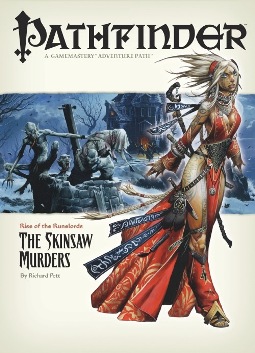 Wizard of the Coast pulls the plug on your license for Dragon and Dungeon Magazine. Were you expecting that, were you prepared, and was the Pathfinder project already in the works at Paizo?
Wizard of the Coast pulls the plug on your license for Dragon and Dungeon Magazine. Were you expecting that, were you prepared, and was the Pathfinder project already in the works at Paizo?
JJ: We knew that the license to continue producing the magazines was coming to an end, but honestly, I was a bit surprised that Wizards of the Coast chose not to renew the license. In hindsight, it makes perfect sense, with their plans to release 4th edition D&D. Pathfinder itself was not yet in production, but we’d already been taking some experimental steps away from magazines at producing our own d20 content at that point with our Complete Encounter line of miniature/adventure packages. Fortunately, WotC gave us a LOT of advance notice when they did decide to not renew our license, so we had just enough time to get Pathfinder started more or less immediately after the final print issues of the magazines.
Rise of the Runelords is a 6 module set, taking characters from 1st to perhaps 17-18th level, what was the thought process behind doing a large series such as this?
The primary goal for Rise of the Runelords was to present a classic campaign — something that we could use to prove to folks that we were just as capable at building fun swords & sorcery RPG campaigns entirely on our own without the D&D license to back us up. We basically wanted to start out with a comfortable, recognizable campaign where you fought a lot of the staples of the game — goblins, giants, dragons, and undead — but with a unique Paizo spin. Rather than invent something entirely new, we wanted to take something old and familiar and comfortable and make it fresh and new all over again.
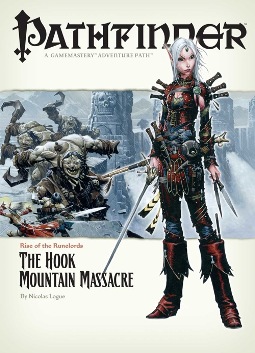 When I look through RotR, I’m given glimpses of great things I’ve seen before in series modules, stuff running back thirty years. Burnt Offerings has a Village of Hommlet feel, while The Hook Mountain Massacre takes me to Keep on the Borderlands, and the final modules make me think of G1-2-3 Against the Giants. Certainly your adventures are different, and more story heavy, but did you draw influences from such classics?
When I look through RotR, I’m given glimpses of great things I’ve seen before in series modules, stuff running back thirty years. Burnt Offerings has a Village of Hommlet feel, while The Hook Mountain Massacre takes me to Keep on the Borderlands, and the final modules make me think of G1-2-3 Against the Giants. Certainly your adventures are different, and more story heavy, but did you draw influences from such classics?
I’ve been playing RPGs since 5th grade, back in 1981 or thereabouts, so I grew up on those older adventures. They’ve always been a part of what I think of as the core game experience, so I absolutely draw inspiration from the 1st edition classics. [Note: In 1981 James would have been 7, and a 5th grader is usually 10-11 years of age which would put the time closer to 84-85.] [Double note: Mystery solved, James is actually 39, so 1981 works]
Module Two: The Skinsaw Murders is an instant classic, period. It’s also for levels 5-7 which are arguably the funniest to play. Can you give me a little background on this adventure?
With Skinsaw Murders, we wanted to not only present a comfortable and well-known adventure site (the haunted house), but to test some boundaries. We wanted to have some mature themes in Pathfinder, and included them from the start, but with Skinsaw Murders, we also wanted to evoke a legitimate feeling of horror. But not just any horror — we were looking to evoke the creepy horror you see in the classic Hammer horror movies — a brooding, nasty, undead horror that creeps up on you. The Skinsaw cult itself was an import directly out of my homebrew campaign that seemed like it would be a perfect fit for what we wanted to accomplish. I’d worked with Richard Pett, the adventure’s author, on several adventures before for Dungeon magazine, and I knew he’d knock this out of the park, so assigning The Skinsaw Murders to him was a no-brainier — a lot of what you see in that adventure comes from Richard as a result.
Unlike most early module series at TSR, your adventure paths are created by different writers in each and every issue. How do you manage the continuity and story line?
Since Pathfinder‘s a monthly product, we can’t really ask a single writer to do an entire campaign — there’s just no time. We have our authors writing their individual installments more or less simultaneously as a result. Getting the six adventures to feel like they’re all part of one campaign is perhaps the hardest part about creating an Adventure Path. We manage it by creating a detailed outline of the entire campaign and all six adventures (for example, the latest Adventure Path we’re starting work on, “Jade Regent,” has an outline that’s almost 18,000 words long — that’s about the length of a 32 page module!) and making sure the six authors all work from that outline as a start. Then, once their manuscripts come in, we have an in-house developer (either myself or Rob McCreary so far) take those six adventures and go through them with the proverbial fine-toothed comb. This stage often results in rewriting — sometimes extensive rewriting — in order to make the six adventures fit together as perfectly as possible. And in this process, we try to make the “voice” of the entire adventure path feel like it’s coming from one person—and again, that usually requires some rewriting. Developing adventures is easily the most time-intensive step of the in-house process of preparing an adventure path for publication.
You wrote Module One: Burnt Offerings, what kind of tone were you trying to establish for the new Pathfinder adventure path that would be the bread and butter for Paizo for years to come?
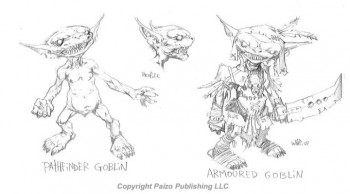
The original marching orders for the first Pathfinder Adventure path were simple — something like, “Make sure the first adventure is something classic and instantly recognizable as a fun adventure.” The “go fight the goblins” plot seemed like the most iconic low-level plotline at the time, so that’s where I started. But I also had a lot of other personal goals for that first adventure. I wanted to establish a place in our new campaign setting that would feel like a good, comfortable “home” for people with the town of Sandpoint — there needed to be something the player characters liked enough to want to defend from goblins, and eventually from undead, giants, and worse. I also wanted to present a compelling story with a whole host of memorable and believable characters — both on the ally side of things and on the enemy side of things. I also wanted to present as much of the new world of Golarion as I could without losing sight of the adventure as a whole — there needed to be a place for every character race and every character class to feel at home in the adventure, for example, and they all needed a chance to shine as well. I wanted to have an adventure with plenty of role-playing opportunities — in my experience, adventures that are nothing more than an endless string of combats are boring, even when those combats are themselves individually interesting encounters. And I wanted to see what I could do with making “boring” monsters like goblins more fun and more interesting. And above all else… it had to hook people on a brand new game world. There were already plenty of published campaign settings out there — I had to make sure that Burnt Offerings not only hooked folks in to wanting to read or play a six-part storyline, but to hook them into wanting to read about the world itself. It was, overall, a pretty stressful adventure to write, but I’m really quite pleased with how it turned out in the end. [Note: I couldn’t agree more, and yes, I’ve played it]
Let’s talk about art. Tell me why Wayne Reynolds, and what your beliefs are concerning him and the incredible success of Pathfinder.
We’d worked with Wayne extensively already — he did a huge amount of covers for Dragon and Dungeon for us, and he also designed the “Dungeon Iconics” as well — a party of 11 adventurers who we introduced to the magazine in issue #114, and would go on to help give the magazine a lot of personality. He was, therefore, an obvious choice to have design our Pathfinder iconic heroes. He’s also such an enormously popular artist among RPGs that having him do the first 12 covers of our flagship line of products was yet another way we could make a big splash and let folks know we were serious about this Pathfinder thing. And when you get right down to it, it was Wayne’s design for the Pathfinder goblin that was the primary inspiration for me when writing about them in the adventure — those goblins have gone on to be, I would say, the most iconic thing we’ve created for our game.
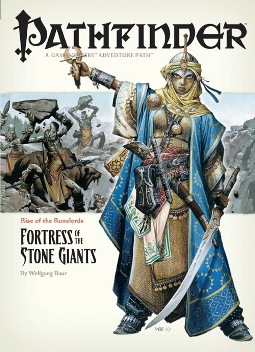 Who came up with the idea of Iconics and how did they translate into your new system?
Who came up with the idea of Iconics and how did they translate into your new system?
I touched a little bit on the idea of the Iconics in the previous answer, but to expand on that — the great value of iconic adventurers is that it gives us a finished character to send to other artists. We don’t have to explain every time to every new artist how a wizard works in the game, or what weapons the rogue can or can’t use, or how a ranger is different from a fighter. We simply use the iconic characters as “control” art. Not only does this save us lots of time in the process of ordering art for other products, but it also helps give Pathfinder a personality. One thing we were surprised at when we did a batch of iconic heroes for Dungeon magazine was just how much the customers fell in love with them — people wanted to know the iconic heroes’ names, their stats, their personalities, everything. So when we came up with the Iconics for Pathfinder, we made sure we were ready to answer those questions. When we were first brainstorming ideas for the Pathfinder Iconics, Erik Mona and I basically sat down with our Art Director at the time, Sean Glenn, and made a list of all the bases—we needed at least one member of every PC race, and we wanted a 50/50 split between male and female, and we wanted to touch upon as many ethnicities as we could. From there, we just made a list. Wayne himself is pretty much responsible for all the look of the Iconics — we might say something to him like, “Paint us a human cleric — she worships a sun goddess, is Arabic looking, and wears chain mail and has a scimitar,” and that’s it. Wayne would come up with all the rest. Then, once we got his art, we’d go about naming the iconic and writing their back-stories. James Sutter and I have probably created the most of those back-stories, but Wes Schneider, Mike McArtor did one or two here and there as well. In the end, creating the Iconics has been a very collaborative effort.
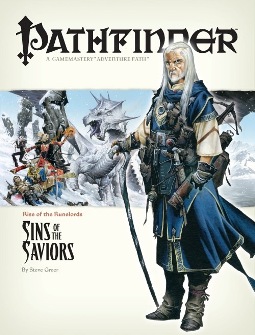 It’s been said the Burnt Offerings was hastily done, and that you struggled with art deadlines which was one of the reasons you included Jeff Laubenstein. Was the backlash to his work so great from your fan base that you truly felt he couldn’t have finished out the series alongside now Pathfinder veterans like Andrew Hou and Kyle Hunter?
It’s been said the Burnt Offerings was hastily done, and that you struggled with art deadlines which was one of the reasons you included Jeff Laubenstein. Was the backlash to his work so great from your fan base that you truly felt he couldn’t have finished out the series alongside now Pathfinder veterans like Andrew Hou and Kyle Hunter?
Burnt Offerings had to launch at Gen Con — launching a new RPG at any other time would have been kinda foolish. Unfortunately, that meant that we had to pull double duty, since the D&D magazines went through to September. As a result, the production cycle for Pathfinder and the last few issues of Dragon and Dungeon overlapped. On top of that, all of that was happening at the height of the convention season — traditionally the busiest and most frantic time of the year for an RPG company. As a result, we were working crazy long hours (I have fever-dream memories of 80 to 90 hour work weeks), so yeah, things were pretty hectic. We really wanted Pathfinder’s art style to be representative of the type of art we were planning on including in ALL Pathfinder products, but with half our artists tied up with doing art for the magazines, and with RPG artists everywhere being slammed for Gen Con release projects, we weren’t able to have a homogenous look to the art in the first few volumes of Pathfinder. As a result, we basically had to scramble to get artists working on whatever we could — Jeff Laubenstein was able to provide art in the very narrow time window we had (and it was VERY narrow indeed!), so we had him do some work for Burnt Offerings even though his style of art didn’t quite match what we were aiming for. It’s not that Jeff’s a bad artist — I actually quite like some of the work he’s done for the magazines and other companies — but his style simply doesn’t match the dark, gritty realistic style we wanted for Pathfinder. We’ve managed since then to achieve that style, but for the first few volumes we did receive a fair amount of feedback from customers who much preferred the more realistic or gritty or painterly styles of artists like Wayne Reynolds, Steven Prescott, Eva Widermann, Ben Wootten, Andrew Hou, and so on. Art that had a more whimsical style, or that had hard outlines (something a lot of our fans called “cartoony”) simply looked out of place in Pathfinder.
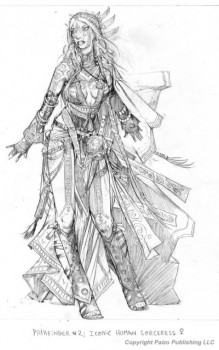
Is there anything that didn’t make it into RotR that players might be interested in, some adventure arch unseen or something you envisioned that didn’t take shape?
There’s always things that end up on the cutting room floor that I wish could have gotten in to any Adventure Path, but with Rise of the Runelords, I think we did a pretty good job getting everything in there that I wanted in there. The original outline for Burnt Offerings had a much longer period between the initial goblin raid on the town and the events at the glassworks, with a sort of insidious plague creeping up from the catacombs below town that would slowly transform townsfolk into sinspawn or otherwise cause monsters to show up here and there in town but that whole section got scrapped when it became apparent that we weren’t going to have room to put all that stuff in there. Beyond Burnt Offerings, I would have liked to have had a bit more room to explore the Sandpoint Hinterlands, or perhaps fully detail all seven wings of Runeforge, or spend a bit more time in Xin-Shalast, but in the end I’m pretty happy with how Runelords turned out.
It’s been an almost universal experience of mine that once gamers and artists start working full time in a gaming company like TSR, WotC, or Paizo, they stop gaming. Is that true of you and the other writers at Paizo?
I can certainly see how starting work at a gaming company can result in that person gaming less. The schedules can be really brutal, and when you spend 50 or 60 or 80 hours during a deadline crunch week to get a bunch of games off to the printer, it’s easy to not want to do anything else game-related during the rest of the week. At Paizo, though, one of the things that we really try to do is not let that happen. In fact, pretty much everyone at Paizo still games, from our boss Lisa on down. I’m currently running two Pathfinder games (one for friends two Saturdays a month, and another for the entire editorial staff every other Thursday evening), playing in two Pathfinder games (one of them a high-level game run by Sean K Reynolds where we all play Drow nobles and another run by Rob McCreary who’s running a heavily modified version of our Kingmaker Adventure Path), and periodically run a Call of Cthulhu campaign as well. And I’ll be joining a new Pathfinder game that Erik Mona’s starting up in a few weeks as well. It’s very much a part of the Paizo community that if you work here, you need to play games. And if you work on Pathfinder itself, at least some of that gaming should be Pathfinder gaming!
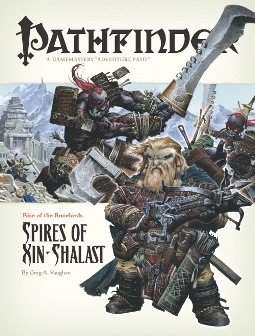 With that, we wrapped up our lunch and I was whisked away to the airport, John O’Neill having no desire to pay for a room for the night, and by evening I was back in L.A. making my desk into a kind of altar to Paizo with all the Pathfinder product I walked away with.
With that, we wrapped up our lunch and I was whisked away to the airport, John O’Neill having no desire to pay for a room for the night, and by evening I was back in L.A. making my desk into a kind of altar to Paizo with all the Pathfinder product I walked away with.
Ok, so now you have to ask yourself, is Paizo the absolute coolest company in the United States? Probably, at least my experience with them indicates as much. This is a company intent on making its product the best it can be. They get talent and don’t let it go, and their management team has been part of some of the most successful game launches of all time. I say if you’ve never had a chance to read or play one of Paizo’s incredible Adventure Paths, now is the time to do so. Why not check them out here.
As for me, I await John’s next mad bout with publishing whimsy, my passport ever ready for a stamp.
Wow! This is all new to me! I know nothing about gaming or art or gaming art, but I do like to look at it. 🙂
Great piece! Thanks for this.
Witch: It’s nice to have a fan 🙂
Theo: Glad you liked it, I was wondering if there were any gamers out there having a look.
Scott: Heck yeah!
Theo: I have to say, I love the name BTW. I totally want to rip it off and use it against my next gaming group 🙂
Do so with my blessing. Anglo-Saxon is a great source for names! (This one being an A-S borrowing from the Gothic.)
Great article!
Always good to see James and Paizo getting the attension they righly deserve. 🙂
(On a side note, James commented on the Paizo forums that he is 39 – and as such was 9 in 1981)
Ingus: They deserve much and more attention as far as I’m concerned. Strange about James, as his Paizo Wiki bio lists his year of birth at 1974, and his first published work was in Dragon at 14, published in July/August 1988, which fits with the Wiki date of birth. If he was indeed born in 71 [the year I was] then he would have been 17 at first publishing, so something is fishey someplace in these records…
[…] can also find the Rune Giant, a Paizo creation from Rise of the Runelords, and a great foe if there ever was one. And if you’re into throwing H.P. Lovecraft inspired […]
[…] first real experience with Pathfinder came with Rise of the Runelords, but that was more a piecemeal type of experiment where I only played what I wanted from the six […]
[…] In fact, I was so taken with the series I interviewed Jacobs about it years ago on Black Gate if you’d like more detail. That interview can be found here. […]